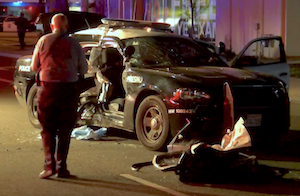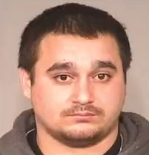Home
A comprehensive resource for safe and responsible laser use
US: UPDATED - Two Calif. men indicted for separate laser-pointing incidents on helicopters
Case 1: Johnny Alexander Quenga, 28, of Fresno
On March 5 2015, the Fresno Police Department helicopter Air 1 was illuminated by green laser light about six times over ten minutes. One crew member, who had been illuminated by lasers numerous times in the past, suffered temporary flashblindness, afterimages, a headache lasting several hours requiring pain medication, and dizziness. He said the beam was much brighter than in his past experience. The pilot had a momentary loss of night vision, and flew a wide orbit to avoid the beam. The pilot directed ground officers to the location.
However, a patrol car on the way to the suspect’s home was broadsided at an intersection by a Toyota 4Runner. The Jaws of Life were needed to rescue one of the officers. Both officers in the car were treated at a hospital for serious injuries. The officer driving was knocked unconscious, had upper body and leg injuries, and some chipped teeth. The passenger officer had a broken leg and a fracture in his back that may require surgery. (The 4Runner driver and passenger suffered minor injuries.)

The Fresno Police Department car that was broadsided on the way to arrest a man who aimed a laser pointer at an FPD helicopter. Two officers were seriously injured. Photo from YourCentralValley.com.
When officers finally reached Quenga’s home, they found he was listening to police department radio traffic. He said “he could hear everything the officers were saying and knew they were looking for him and [he] had possibly hidden the laser.” Quenga claimed the laser beam came from a house behind him. He further said he worked as a security guard and knew he could lose his job for misuse of a laser.

The airsoft gun, equipped with a green laser sight, said to be aimed by Quenga at a police department helicopter
Ars Technica reporter Cyrus Farivar, writing in a detailed article about the incident, asked federal prosecutor Karen Escobar if Quenga had “somehow caused” the patrol car crash. She replied that Quenga’s sentence “shall be determined, in part, on the basis of ‘all harm that resulted from the acts and omissions’ caused by him.”

Johnny Quenga
Quenga was charged with interfering with the safe operation of an aircraft, which could result in up to 20 years in prison and up to a $250,000 fine. He was also charged with aiming the beam of a laser pointer at an aircraft, which could result in up to five years in prison and up to a $250,000 fine.
Case 2: Barry Lee Bowser Jr., 51, of Bakersfield
On September 12 2014, Bowser aimed a green laser beam at the Kern County Sheriff’s helicopter Air-1 while it was supporting ground units responding to a man armed with a gun. The mission was diverted and the pilot had vision difficulties. Bowser fled Bakersfield after the incident as was arrested in San Luis Obispo.
Bowser was charged with aiming the beam of a laser pointer at an aircraft. As with Quenga, he could face up to five years in prison and up to a $250,000 fine.
Reporter Farivar noted that Escobar has become the top prosecutor for laser cases in the U.S. Between federal and state convictions in her Eastern District of California (which includes Fresno, Sacramento and Bakersfield), more than 35 percent of the total U.S. laser strike convictions have come from Escobar’s district. Since the FBI began keeping track 10 years ago, there have been “less than 100 total laser strike convictions nationwide — state and federal…” according to Farivar.
From a Department of Justice press release, Ars Technica, and YourCentralValley.com
UPDATED January 19 2016 — Quenga was sentenced to six months in prison plus three years of supervised release. From the Fresno Bee. Ars Technica quoted prosecutor Karen Escobar as saying “We are still litigating the restitution portion of the case. In that regard, a hearing on restitution has been set for May 16. We are seeking the uninsured losses in connection with the accident of the first responders that Quenga was monitoring via his police radio scanner iPhone app."
UPDATED September 23 2016 — Bowser was sentenced in September 28 2015 to two years in prison plus three years of supervised release, plus a $10,000 “special assessment fee.” On September 23 2016, Bowser wrote a public letter of apology saying he lost his “entire life” for shining a laser at a helicopter for three seconds. More on the letter is here.
UPDATED December 20 2016 — Ars Technica editor Cyrus Farivar published a 4,000-word profile of Bowser’s life and case. It is one of the few in-depth examinations of a laser pointer arrest, conviction and aftermath.